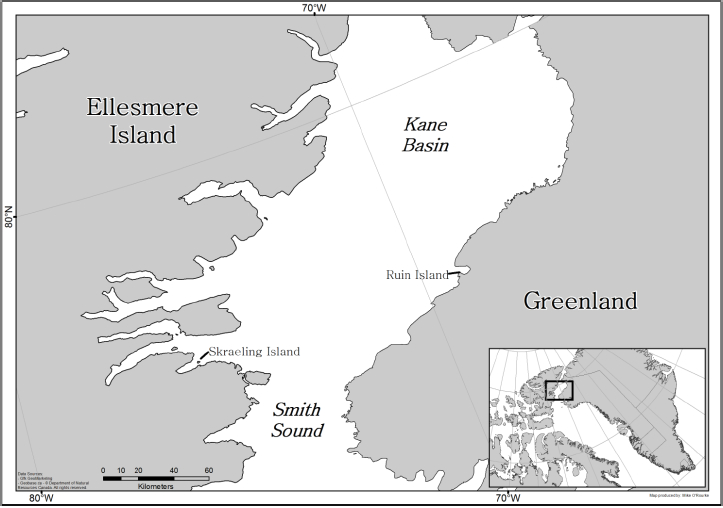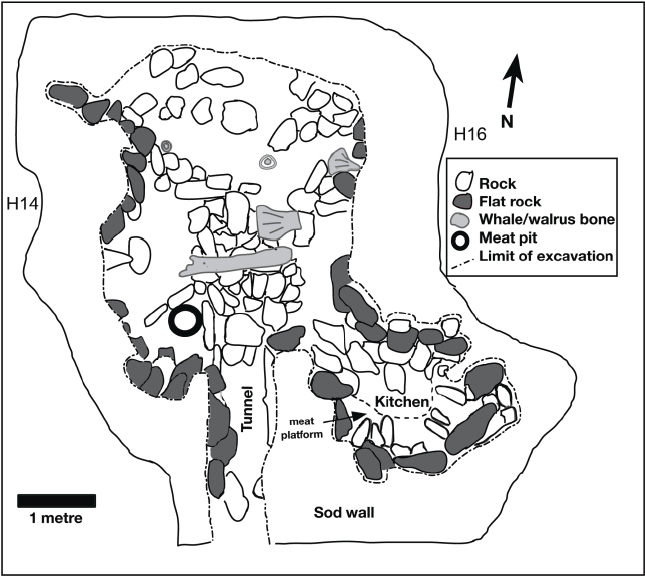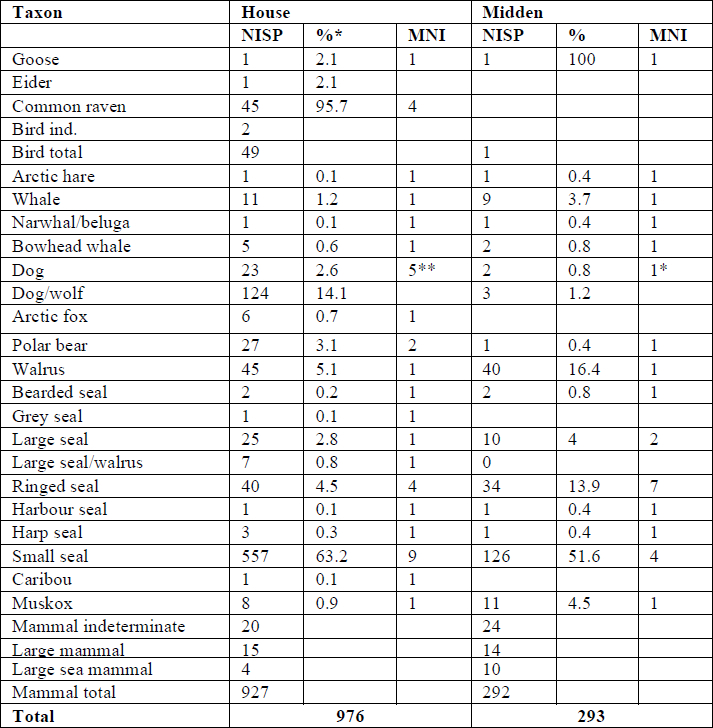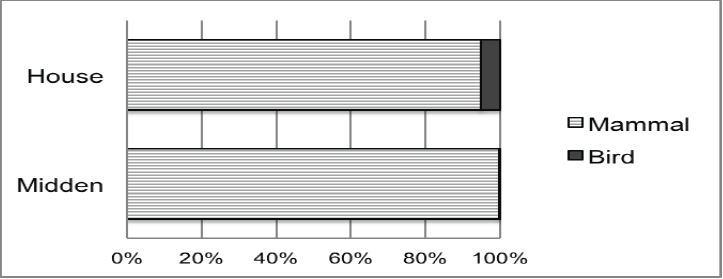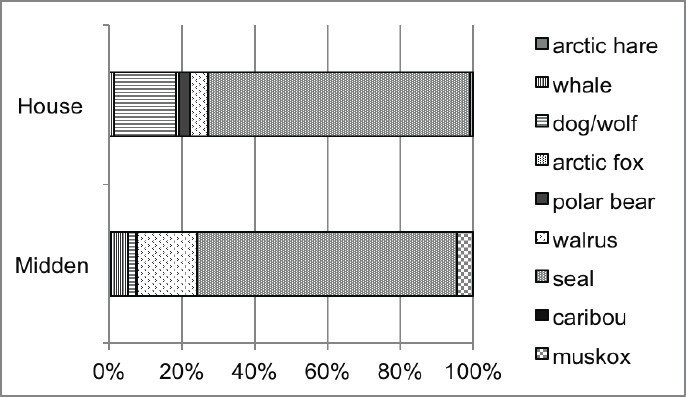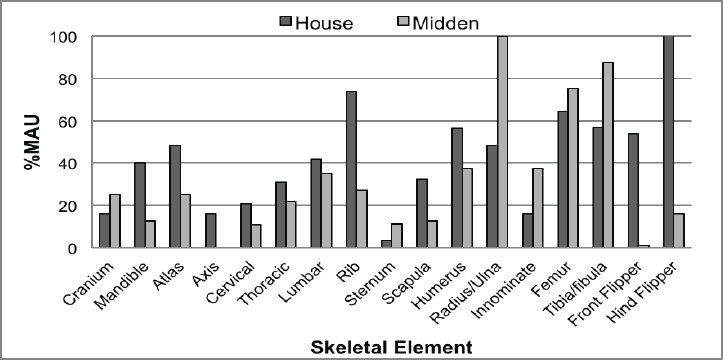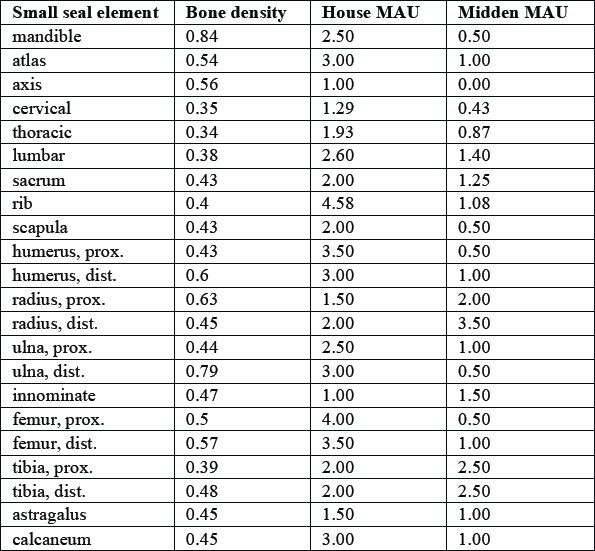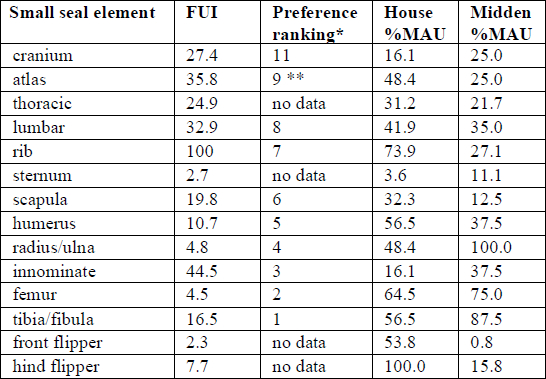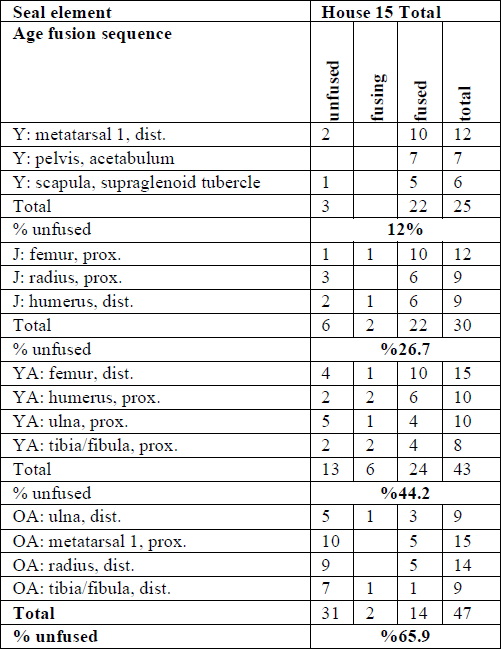Abstracts
Abstract
This paper presents the faunal material excavated from an Early Thule Inuit semi-subterranean house, house 15, from the Skraeling Island site (SfFk-4). In an effort to understand how the occupants of the house interacted with animals, a fine-grained zooarchaeological analysis is employed. Patterning in taxonomic and bone modification frequencies, skeletal element distributions, and prey demography are discussed. Inuit oral histories, mythology, and ethnographic sources are used to help interpret the results of the analysis and reconstruct the group’s subsistence economy.
Résumé
Cet article présente le matériel faunique provenant d’une habitation semi-souterraine datant du Thuléen ancien, l’habitation 15, située sur l’île Skraeling (SfFk-4). Afin de comprendre l’interaction entre les occupants de l’habitation et les animaux, une analyse détaillée des données zooarchéologiques a été produite. La répartition taxonomique, les fréquences des modifications des os, la répartition des éléments du squelette et la démographie des proies sont discutées. L’histoire orale inuit ainsi que les sources mythologiques et ethnographiques ont été utilisées pour contribuer à l’interprétation des résultats de l’analyse et pour reconstruire l’économie de subsistance du groupe.
Article body
Introduction
The Early Thule Inuit[1] first migrated into the Eastern Arctic from a homeland somewhere in northwestern or western Alaska (Gulløv 2004; Mathiassen 1927; McGhee 1984; Morrison 1999); however, the place of origin is still a matter of debate (see Mason and Bowers 2009). The Early Thule Inuit occupation of Skraeling Island (Figure 1) is recognised as one of the earliest Inuit occupations in the Eastern Arctic and forms part of the Ruin Island phase of the Thule culture (Friesen and Arnold 2008; Gulløv 1997; McCullough 1989; Morrison 1999; Schledermann and McCullough 1980). A comparative analysis of selected traits by Karen McCullough (1989) strongly suggests that the Early Thule Inuit society of Skraeling Island originated in western Alaska. This phase was characterised by material culture very similar to that of Alaskan Thule sites, including harpoon head types and a house layout where a separate kitchen was accessed by a tunnel that ran parallel to the main entrance tunnel (Holtved 1944; Schledermann 1978). Excavations on Skraeling Island have uncovered several traits reminiscent of Alaskan Thule Inuit traditions, including house styles, harpoon heads, clay pottery, and various household utensils (Schledermann and McCullough 1980). There are also similarities between the types of tree species whose wood was used as raw material (Alix 2009).
For this paper, I investigated the faunal remains from an Early Thule Inuit winter house structure, house 15, and its associated midden at the Skraeling Island site (SfFk-4). In an effort to understand how the Early Thule Inuit occupants of this house interacted with animals, I conducted a fine-grained zooarchaeological analysis. While also considering taphonomic factors, I examined hunting strategies, consumption practices, and disposal of animal bones. The zooarchaeological record was interpreted with reference to the traditional life-ways of Inuit societies, specifically human-animal interaction as recounted in oral histories, mythology, and ethnographic research.
Ruin Islanders and the Skraeling Island site
Eric Holtved (1944) originally defined the Ruin Island phase after excavating several Early Thule sites located on the Greenland side of Smith Sound, particularly those on Ruin Island. Through archaeological investigations between 1978 and 1980, Schledermann and McCullough uncovered several sites with Ruin Island traits on the east coast of Ellesmere Island, including several on Skraeling Island (McCullough 1989; Schledermann 1978; Schledermann and McCullough 1980).
Skraeling Island is a small island with many raised gravel-beach ridges. The island is on the western border of the North Water Polynya (Barber and Massom 2007), just south of the Flagler Bay polynyas (Schledermann 1980; Stirling 1980), and near several secondary, less stable, polynya concentrations. The close proximity to these ice-free waters would have made Skraeling Island an attractive location to Arctic peoples, as important marine resources were readily accessible year-round. Large populations of beluga (Delphinapterus leucas), narwhal (Monodon monoceros), bowhead whale (Balaena mysticetus), and walrus (Odobenus rosmarus) are found during the summer months (Stirling 1980), and smaller frequencies of these animals can be found in the North Water Polynya during the winter. Polar bears (Ursus maritimus) are present year-round and abundant along the edge of the polynyas throughout the winter (ibid.). Various seal species can be found in the surrounding waters, including ringed seal (Pusa hispida) and bearded seal (Erignathus barbatus), which are also year-round residents. Harp seals (Phoca groenlandica) can be found off the coast during the summer migration (Rosendahl 1961; Sergeant 1991). Also, harbour seals (Phoca vitulina), which are year-round residents of Baffin Bay, will on occasion make their way into the North Water Polynya (Mansfield 1967). Birds are abundant in the region, different species of ducks and geese nest on the island (Schledermann 1980), and various jaeger species, gull species, ravens, and loons are common (Godfrey 1966). In addition, the North Water Polynya is host to the largest number of seabirds known in the Arctic (Karnovsky and Hunt 2002), and marine fish are plentiful.
Figure 1
The location of Skraeling Island, in the Canadian High Arctic. Map by Mike O’Rourke.
Across Skraeling Island are the remains of settlements belonging to early Palaeo-Eskimo peoples and Thule Inuit (Schledermann 1990). At the Skraeling Island site, on the southern extension of the island, a total of 23 Thule Inuit house ruins, numerous tent rings, kayak and umiak supports, and food caches have been identified (Schledermann and McCullough 1980; McCullough 1989). Seventeen of the Thule winter houses appear in five clusters, with the remaining six staggered across the site. All of them have been at least partially excavated (McCullough 1989). This text focuses on the distribution of faunal material from house 15 and its associated midden. Three radiocarbon dates were obtained from the structure. A sample of Norse wool produced a radiocarbon date of A.D. 1190±60 calibrated years (sample number GSC3038); however, a date of A.D. 1300±80 based on willow and A.D. 1370±60 based on heather were also obtained (sample numbers GSC2924 and GSC3059; ibid.: 241). These dates, in addition to several Early Thule Inuit artefacts, which include fragments of pottery forged in Alaska (Schledermann and McCullough 1980), suggest that the house was occupied by Early Thule Inuit pioneers sometime during the 13th century.
House 15 exhibited the most substantial superstructure at the site and incorporated a larger quantity of whalebone than all other house structures. McCullough (1989: 54) estimated a minimum of two bowhead whales were used to construct the house. This house had a single room measuring 3.9 x 3.4 m, whose front portion was flagged with stones and fragments of whale scapulae and mandibles (Figure 2). A raised sleeping platform was identified at the rear of the structure where the flagstones end and where a gravel brim appears along each side of the central floor. Walrus bones were also incorporated into the structure, notably seven skulls and mandibles embedded in the north wall (McCullough 1989). A substantial kitchen extension had been built to the east of the house. The kitchen tunnel was 1.3 m x 75 cm wide and approximately 60 cm high. The kitchen itself measured 2.9 m x 1.8 m and the rear cooking platform had three separate hearth units. At the south end of the kitchen, an alcove presumably functioned as a meat locker (ibid.: 54). House 15 was situated between two additional winter house structures, houses 14 and 16, which obliterated the east and west walls of the house, an indication that they were constructed after house 15 had been abandoned. After abandonment, house 15 appears to have served as a midden for the neighbouring structures (McCullough 1989). Analysis was performed on all the faunal remains from house 15, except for those from part of the entrance tunnel. Discussion here will be limited, however, to the faunal remains from the floor level, from the sleeping platform, and from below the flagstones. The upper levels were considered fill and not included for analysis because my concern was how the occupants of house 15 interacted with animals. In addition, six m2 of a midden were excavated in front of house 15’s entrance tunnel, and its faunal remains also analysed for the following discussion.
Zooarchaeology at the Skraeling Island site
Zooarchaeological analysis can offer valuable insights into how past peoples behaved and how they interacted with animals, in particular by informing us about the role of animals in the diet, in social relations, and in symbolism (Russell 2012). Animal bones are, however, distributed at archaeological sites in ways that result not only from past human behaviours but also from taphonomic processes (Lyman 1994, 2008). The role of these processes is thus considered at each stage of the analysis. In addition, because site formation processes, including cleaning practices and trampling, differentially impact the faunal remains in houses and middens, these contexts need to be considered separately.
Figure 2
Plan of Early Thule Inuit house 15, Skraeling Island, after McCullough (1989: 55).
The animal bone samples from the house and the midden were identified on the basis of the reference collections at the University of Toronto and the Canadian Museum of Nature. In addition, illustrations of seal skeletal elements found in Hodgetts (1999) and the online database VZAP (Virtual Zooarchaeology of the Arctic, see Betts et al. 2011) were used to complement the physical reference collections. The faunal remains from all contexts were exceptionally well preserved, with the majority of bone specimens exhibiting periosteum, cartilage and, in some cases, fur. Mammals were the most numerous taxa in both contexts, accounting for 94.9% of the identified bones from the house and 99.6% of the identified bones from the midden (Table 1). Bird bones were more frequent within the house, comprising 5% of the identified bones, versus only 0.3% of the identified bones from the midden. Fish were absent from both features (Figure 3). The mammal and bird remains had significantly different distributions (X2=13.4, p<0.001), an indication that the processes at work were not random but rather human behaviour or taphonomic processes.
Table 1
Taxonomic frequencies for house 15 and midden faunal assemblages.
NISP= number of identified specimens, MNI= minimum number of individuals
* Percentages are by class and based on those specimens assigned to species.
**MNI estimate for dog and dog/wolf is a combined value.
The higher frequency of bird remains within the house was likely due to a combination of factors. For instance, a relatively lower frequency of bird bones from the midden may have resulted from scavenging by dogs or foxes, as they would presumably have had greater access to the midden than to the house area (see Friesen and Betts 2004; Whitridge 2002). It is also possible that cleaning practices contributed to a higher frequency of bird bones within the house, as the small size of the bones would have made them less likely to be removed and re-deposited in the midden (Lamotta and Schiffer 1999).
Figure 3
The class frequencies for house 15 and the associated midden, Skraeling Island, expressed as %NISP (number of identified specimens).
Seal bones dominated the faunal samples, contributing 67.9% of the identified mammal remains from the house, and 68% of the identified mammal remains from the midden (Figure 4). Several seal species were identified, and when the species could not be determined the remains were categorised as either large or small seal. Of the identified seal species, ringed seals were most frequent. There were also harbour seals, harp seals, and bearded seals from both features and one grey seal from the house (Table 1).
The second most frequent resource varied in frequency from the house to the midden (Figure 4). In the house, dog/wolf remains comprised 16.7% of the sample, yet contributed only 2% of the identified mammal remains from the midden. In the midden, walrus remains were the second most frequent resource, comprising 16.4% of identified mammal remains. There was a significantly lower frequency of walrus remains in the house, where they formed 4.8% of the identified mammal remains. Additional species, such as polar bear, bowhead, narwhal, muskox, caribou, arctic fox, and arctic hare, were identified in both features but comprised no more than 4% of the identified mammal species. Of the identified bird remains, the common raven was the most frequent species in the house, forming 95.7%, with eider and goose each contributing 2.1% (Table 1). In the midden, the single bird specimen was a goose.
Figure 4
The distribution of mammals expressed as %NISP (number of identified specimens).
Animal element distribution
By measuring the presence and distribution of animal skeletal elements, we can infer how an animal was killed and transported, and how it was butchered, consumed, and disposed (Binford 1978). Quite often, the distribution of animal elements is impacted by density-mediated attrition, as elements that have high meat utility tend to have low bone density and are thus more vulnerable to taphonomic processes (Lyman 1984, 1992). To determine whether bone density played a role in the representation of bones from small seals, the minimum number of animal units (MAU) was compared with bone density (Figure 5, Table 2). Bone density did not correlate with small seal MAU from the house (rs=0.14, p=0.54) or from the midden (rs=-0.11, p=0.64) and thus was probably not a factor in the distribution of bones from small seals within each feature. The impacts of chemical and mechanical processes would have been nominal, as these processes would have had greater impact on elements of low density. This finding increases the likelihood that humans or carnivores had removed elements high in density.
The distribution of bones from small seals was also compared with the food utility index (FUI) of small seals (Table 3). The FUI of small seals did not correlate with %MAU from the house (rs=0.14, p=0.62) or from the midden (rs=0.19, p=0.5). Thus, food utility played no role in the distribution of bones from small seals in the house or in the midden. A preference-ranking index was also applied (Table 3). This qualitative measure has been used to assess the role of sensory characteristics, including taste, smell, and texture, in the meat preferences of Iñupiat, from Barrow, Alaska (Diab 1998). The preference-ranking index did not significantly correlate with small seal distribution within the house (rs=0.24, p=0.47); however, there was a strong positive correlation between the preference-ranking index and small seal MAU from the midden (rs=0.73, p=0.01). This finding is difficult to explain, particularly why preferred elements, including tibiae/fibulae and femora, were found in high frequencies in the midden and not in the house (Table 3). A combination of factors was likely responsible, including element preference, butchery of the animal and, possibly, food-sharing practices.
Figure 5
Small seal element distribution based on %MAU (minimum number of animal units).
Table 2
The values of bone mineral density for small seals after Lyman (1994) and MAU (minimal animal units) of small seals from the house and the midden.
Table 3
The small seal FUI (food utility index) (Lyman 1992), Iñupiat preference ranking (Diab 1998), and %MAU (minimum number of animal units) of small seals from both the house and the midden.
The distribution of skeletal elements was also examined for the second most frequent resource within both features, as well as for bird remains. A high frequency of dog/wolf elements was found in the house. Except for the skull and the humeri, all parts of the dog/wolf skeleton were identified, the axis vertebrae being the most abundant parts. The entire skeleton was less represented in dog/wolf remains from the midden, there being one complete caudal vertebra, fragments of the hipbone and the tibia, and a thoracic vertebra. Various portions of the walrus skeleton were identified, skulls being well represented in both contexts, crania most abundant in the house, and mandibles most abundant in the midden. As well, among those elements from the house whose side could be determined, all were from the left side of the skeleton. The majority of the common raven specimens were articulated and complete with the exception of missing vertebrae and foot phalanges. Waterfowl specimens were limited to leg and wing elements.
Modification frequencies
All modifications to the bone specimens, including cut marks, burning, gnaw marks, and fragmentation, were recorded during the faunal identification (Table 4). This was done in order to better understand how various taphonomic factors impacted the faunal distribution at the site. Cut marks were found on 9.4% of the bones from the house, and 2.4% of the bones in the midden. Each mammal species displayed cut marks indicative of different activities, including: disarticulation, when cut marks were found near joints; skinning, when cut marks encircled the shafts of lower limb bones or were found at the base of antlers, ears, mouth and chin; and meat removal, when cut marks were found at the mid-diaphysis (Binford 1981). Bones from the house had a higher frequency of cut marks, perhaps as a result of meat removal and consumption practices. Bones from the midden likely had a lower frequency because they were removed during the initial butchery of the animal (see Friesen and Betts 2004).
Gnaw marks were also more frequent on bones found within the house, where they appear on 11.4% of the mammal bones (Table 4). In the midden, gnaw marks appeared only on 3.8% of the mammal bones. This distribution was unexpected, as dogs likely would have had greater access to the midden than to the house. It seems that midden deposits accumulate quickly during the winter and frequently become encased in permafrost soon after deposal; the upper levels also often serve to protect lower levels from scavenger activity. Both factors may explain the low frequency of gnaw marks on the bone specimens from the midden. In addition, gnawing may have occurred once the house had been abandoned and had thus become accessible to entry by dogs.
Burnt bones were infrequent at the site, representing 0.3% of the mammal bones within the structure and being absent from the midden. The low frequency of burnt bones may indicate that boiling was a favoured cooking practice (see Friesen and Betts 2004), or perhaps they were removed from the structure and deposited elsewhere. Bone fragmentation was calculated using the NISP:MNE ratios of mammal bones (Lyman 1994). Fragmentation rates were low in both features: 1.1 in the house and 1.4 in the midden. Apart from the gnawing, it seems that the bone specimens in both features were not greatly impacted by trampling and that bone specimens were not heavily processed after initial disarticulation and skin and meat removal.
Table 4
Frequencies of modifications to mammal remains.
Seasonal indicators and prey demography
The faunal list provides some indication of the season(s) during which the animal specimens from the house had been killed and when the house may have been inhabited. Warm season migrants were present, including eider, goose, and harp seal, but in low frequencies (Table 1). Most faunal specimens from the house and the midden were yearlong residents, including ringed and bearded seal, walrus, beluga, narwhal, bowhead, and polar bear.
In small seals, the fusion of skeletal elements was analysed in order to estimate the distribution of ages at death. Using this method, specimens were categorised into four skeletal age groups: yearlings, i.e. killed in the first year of life; juveniles, i.e. killed between one and four years of age; young adults, i.e. killed between four and seven; and old adults, i.e. at least 7.5 years old when killed (Storå 2002). In modern small seal populations, the fusion of various skeletal elements occurs in a predictable sequence (ibid.). For this analysis, the samples from both the house and the midden were combined because both samples presumably came from the same group (Table 5). The data indicate that at least one seal had been killed before it could reach the age of six months, its death being thus sometime between April and September. Juveniles, young seals, and old adults were also identified (Table 5). Though insufficient, the data may point to seasonably variable hunting (see Gotfredsen 2010). For instance, yearlings tend to occupy areas of land-fast ice until they are weaned, as do older adults (Smith 1973, 1987); thus, these animals could have been harvested during the spring or early summer when the land-fast ice was still present. However, juveniles and young adults prefer the ice edge along open waters (ibid.) and were likely taken at the ice edge along either the Flalger Bay or North Water polynyas sometime during the winter or spring.
In addition to indicating the type of species and the age distribution of small seals, the robust architecture of house 15 is consistent with cold weather occupation. Although the houses might have also been used during warm weather (see Nagy 1994), it is more likely that several tent rings found on Skraeling Island were occupied during the summer months. In this case, it seems likely that the harp seal and the yearling were caught during the summer but stored until the winter when they were consumed (see Lantis 1984). This seasonal occupation would also account for the low frequency of bird remains at the site.
Table 5
Unfused seal element frequencies expressed as MNE (minimum number of elements).
Inuit and animal interaction at the Skraeling Island site
House 15 and its associated midden yielded a distribution and frequency of animal species that is generally consistent with other coastal Early Thule sites in the Eastern Arctic, where faunal assemblages are predominantly bones from small seals (Darwent and Foin 2010; Mathiassen 1927; McCullough 1989; Park 1989; Sabo 1981; Taylor 1972; Whitridge 1992)
. As discussed in the previous section, the age distribution of small seals within the house and the midden suggests that seals were hunted on the land-fast ice and along the polynyas. Evidence of open water hunting is also consistent with the identified presence of migratory harp seals, as these animals tend to stay offshore near pack ice (Sergeant 1991). In addition, open water hunting would have targeted whales and, potentially, walrus during the summer months.
The prevalence of bowhead whale bones at Early Thule sites, including the Skraeling Island site, suggests that bowhead whale hunting was likely very important to these groups and key to the scheduling of seasonal activities (McCartney 1980). It is difficult, however, to estimate how many were harvested and the degree to which they were relied upon for food, since whale bones were often conserved as building materials (Park 1989). A recently developed model involves recounting of bones at archaeological sites to evaluate Early Thule Inuit bowhead use (Savelle 2010). Thus far, this avenue of research has indicated that Early Thule Inuit whale harvesting may have actually been higher in some regions than once thought. If we also take into account the large amount of meat and blubber on a single bowhead, it seems that this whale species was likely the focal point of local subsistence and hunting activities wherever it was readily available. Thus, the faunal assemblages recovered from many Early Thule Inuit sites are composed primarily of secondary prey species (see Staab 1979)
. Hunting of these other species would have nonetheless been an integral part of Early Thule Inuit society, even where whale hunting was also likely important, and especially in years when whales were not captured or when stored meat spoiled. Such was probably the case at Skraeling Island, as suggested by the prevalence of seal bones within house 15 and its associated midden deposit.
An unusual find at the site was the remains of a grey seal, as this species typically occupies more temperate waters (Rice 1998). Today, its geographic range includes the area surrounding Sable Island, the Gulf of St. Lawrence, and the northeast Atlantic off Iceland, Norway, and Ireland and the Baltic and White seas (Hall 2002). Though rare, their presence in Greenland was reported by the 18th-century Danish missionary and zoologist Otto Fabricius, who described the seal in his Detailed Description of the Seals of Greenland on the basis of an Inuit name for this species (Kapel 2005). This said, he never encountered one himself, nor had he met a hunter who had. In addition, the 19th-century Scottish explorer Robert Brown (1868) claimed to have collected a grey seal skull found near Disko Island, yet the seal skull was destroyed and its species identity could not be confirmed. The first confirmed sighting of a grey seal in Greenland occurred in 2009 when a lone grey seal was spotted near the coast of Southeast Greenland (Rosing-Asvid et al. 2010). The grey seal bones at the Skraeling Island site suggest that this species may have periodically made trips further north than previously noted. As the house was occupied during the Medieval Warm Period, the northern waters along the east coast of Ellesmere Island would have remained ice-free longer. Thus, the productivity of the Flalger Bay and North Water polynya would have made the area an attractive respite for a wandering grey seal.
While the skeletal parts of small seals varied between the house and the midden, vertebrae were consistently underrepresented. This pattern may have resulted from dog feeding practices (see Diab 1998), as seal meat is commonly used to sustain dog teams, particularly during the winter when they are regularly used for transportation (Nelson 1969; Smith 1991). The high frequency of hind flippers within the house may be related not to subsistence activities but to entertainment. For instance, Inuit traditionally used seal phalanges in a game called inugah, which was typically played during the long winter months (Culin 1907). Although the Early Thule Inuit occupants of this house may have played something similar, this game was not restricted to the bones of the hind flipper. Alternatively, the high frequency of hind flippers may be related to food preference and food-sharing practices. Preference for hind flipper seal meat is well known among the Inuit (Freuchen 1935: 227), as is sharing of hind flippers among Central Arctic Inuit (Damas 1972; Van de Velde 1976). As noted by McCullough (1988), the lower frequencies of fore flipper bones could, in part, be explained by the retention of these elements on sealskin floats (Holtved 1967: 87; Kroeber 1899).
Dog remains were quite frequent within house 15 and represented at least five animals (Table 1). This high frequency has several possible explanations. In Inuit society, dogs pulled sleds, this being the main mode of transportation during the winter. They were used also while hunting to find the breathing holes of seals and to corral large animals such as polar bears. During the summer months, they were sometimes pack animals. Finally, they could become a source of food when supplies ran low, as suggested by oral traditions and ethnographic research from all Arctic regions (e.g., Rasmussen and Koch 1921). The presence of cut marks on dog vertebrae and joints suggests that these dogs had been disarticulated and eaten. However, the large portion of periosteum attached to the bone specimens from both the house and the midden implies that at least some dogs were not consumed out of starvation. These dogs may also have been killed for their fur. In the Western Arctic, dog fur has traditionally been incorporated into clothing and bedding. John Murdoch (1892: 110) recounts that winter mittens were often made out of dog skin amongst the Inuit of Northwest Alaska. Edward Nelson (1899: 31) also states that dog skin was used to make men’s trousers. Of the cut marks on dog remains from the house and the midden, several encircled the lower limbs, a sign that these animals had been skinned. In addition, fur-bearing animals comprised a very small proportion of identified species, this being indirect support for the idea that dog fur was used for clothing. It remains unclear whether these dogs died of natural causes or were specifically killed for their meat or fur.
As mentioned earlier, walrus skulls were incorporated throughout the house structure. Most noteworthy are the seven walrus skulls and mandibles built into the north wall (McCullough 1989). In many hunter-gatherer societies, the skull is often thought to be where the soul resides. Among northern Alaskan Inuit, according to Robert Spencer (1959: 164), walrus heads were given to the owner of the hunting boat, the umialik (pl. umialiit). By incorporating walrus skulls into the north wall of house 15, the occupants might have been displaying their community status. However, there was likely more cooperation and less status differentiation among pioneering Thule Inuit families, like those who occupied the Skraeling Island site, in order to ensure survival of the group (see Morrison 1999). Walrus skulls were included in the house structure of a contact-era house in Wales, northwestern Alaska (Harritt 2010). In this house, however, the skulls were on the exterior walls and visible to all. In addition, Barrow Inuit believed that once a sea mammal had been killed, it could return and assume a monstrous shape if its carcass was treated improperly (Spencer 1959: 263). As a result, the common practice was to remove the animal’s head so that the spirit could escape, thus preventing any act of vengeance. It may be, then, that the treatment of these skulls could have been a means of appeasing the animal spirits.
Forty-five walrus specimens were identified from the floor of the house in addition to the walrus skulls in the house walls. Of these, 20 specimens were ribs or from the appendicular skeleton. Of the 18 whose side could be determined, all were from the left side. These remains were not limited to one part of the skeleton but included parts of the front and hind limbs. Seemingly, this pattern is not the result of poor bone preservation or dog activity, and there is no known ethnographic analogy that explains this skeletal element distribution. While meat sharing was likely practised by Early Thule Inuit groups in a similar manner to that of ethnographically known groups (see Damas 1972), these practices tended to involve the sharing of particular body parts, not the entire side of an animal. For now, this pattern is unique to house 15 and may be specific to a single site rather than being an established practice.
The low frequency of bird bones suggests that birds contributed little to the diet of the occupants of house 15, who appear to have heavily relied upon stored meat. The house did yield, however, at least four common raven (Table 1). The raven bones were not heavily processed, most of them being articulated and found whole. If dogs or foxes had caught these birds, the bones would have likely been more fragmentary. While these birds may have died of natural causes in the house, it is possible that they were conserved for more symbolic reasons. Across the Arctic, ravens figure predominately in Inuit mythology (Boas 1901; Nelson 1899; Rasmussen and Worster 1921), and a number of ethnohistoric sources refer to ravens as being used as amulets. At Point Barrow, Murdoch (1892: 275) states that the whaling umialiit used dried ravens to ensure the success of a hunt. Søby (1968-70: 49) notes that raven skins were hung down the back of the umialiit. At Kotzebue Sound, Frederick Beechey (1831: 458) describes the Inuit he encountered as having “had some skins of ravens with them, upon which they placed a high price” and that “on several occasions we had noticed the beaks and claws of these birds attached to ornamental bands for the head and waist, and they were evidently considered valuable.” Thus, it seems that these birds were not consumed as food but may instead have had a symbolic significance and figured importantly in hunting practices.
Conclusion
The faunal remains from the Skraeling Island site suggest that the Early Thule Inuit of Skraeling Island focused their hunting efforts on a few key resources, as did Thule Inuit across the Arctic and later Inuit societies. By examining how animal bones were distributed within house 15 and its associated midden, it is possible to reconstruct not only the subsistence economy but also everyday rituals or taboos that were similar to those practised by more recent Inuit groups. The raven’s possible symbolic function, the display of walrus skulls in the house structure, and even the use of dog fur express the more social aspects of human-animal interaction at the Skraeling Island site, thereby exemplifying Inuit cultural traditions that would continue throughout the prehistory and history of Alaska and the Eastern Arctic.
Appendices
Note
-
[1]
The term Thule Inuit refers to prehistoric Inuit who were the ancestors of modern Inuit.
Appendices
Acknowledgments
I owe many thanks to Karen McCullough who supported my examination of several faunal samples from the Skraeling Island site, including the material discussed here. I am also grateful to the Canadian Museum of Civilization, where the material is stored, for granting me access to the faunal samples. An earlier draft of this paper was presented in an Arctic session at the 110th Annual Meeting of the American Anthropological Association in Montreal. I want to thank Sean Desjardin, Sarah Hazell, and Marie-Pierre Gadoua for inviting me to participate in that session as well as the presenters and discussants who again awakened my love for the Arctic. I owe many thanks to Michael O’Rourke who prepared Figure 1. I am very grateful to several people who provided me with helpful comments on earlier versions of this paper.
References
- ALIX, Claire, 2009 Driftwood, Timber and Shrubs! Wood Used by Ruin Islander Thule at Skraeling Island, Eastern Ellesmere Island, Canada, in B. Grønnow (ed.), On the Track of the Thule Culture from Bering Strait to East Greenland: Proceedings of the SILA Conference “The Thule Culture-New Perspectives in Inuit Prehistory,” Copenhagen, Oct. 26th-28th, 2006. Papers in Honour of Hans Christian Gulløv, Copenhagen, National Museum of Denmark, Publications from the National Museum, Studies in Archaeology and History, 15: 149-165.
- BARBER, David G., and Robert A. MASSOM, 2007 Chapter 1. The Role of Sea Ice in Arctic and Antarctic Polynyas, in W.O. Smith and D.G. Barber (eds), Polynyas: Windows to the World, Amsterdam, Elsevier Oceanography Series, 74: 1-54.
- BEECHEY, Frederick William, 1831 Narrative of a voyage to the Pacific and Beering's Strait, to co-operate with the polar expeditions: Performed in His Majesty's ship Blossom, under the command of Captain F.W. Beechey, R.N., F.R.S. &c. in the years 1825, 26, 27, 28, volume 1, London, Authority of the Lords Commissioners of the Admiralty.
- BETTS, Matthew, Herbert MASCHNER, Corey SCHOU, Robert SCHLADER, Jonathan HOLMES, Nicholas CLEMENT and Michael SMUIN, 2011 Virtual zooarchaeology: Building a web-based reference collection of northern vertebrates for archaeofaunal research and education, Journal of Archaeological Science 38(4): 755-762.
- BROWN, Robert, 1868 On the mammalian fauna of Greenland, Proceedings of the Zoological Society of London, 1868: 330-362.
- BINFORD, Lewis R., 1978 Nunamiut ethnoarchaeology, New York, Academic Press.
- BINFORD, Lewis R., 1981 Bones: Ancient Men and Modern Myths, New York, Academic Press.
- CULIN, Stewart, 1907 Games of the North American Indians, Washington, Smithsonian Institution, Annual Report for the Bureau of American Ethnology, 24.
- DAMAS, David, 1972 Central Eskimo Systems of Food Sharing, Ethnology, 11(3): 220-240.
- DARWENT, Christyann and Jeremy FOIN, 2010 Zooarchaeological Analysis of a Late Dorset and an Early Thule Dwelling at Cape Grinnell, Northwest Greenland, Geografisk Tidsskrift-Danish Journal of Geography, 11(2): 315-336.
- DIAB, Mark C., 1998 Economic Utility of the Ringed Seal (Phoca hispida): Implications for Arctic Archaeology, Journal of Archaeological Science, 25(1): 1-26.
- FREUCHEN, Peter, 1935 Field Notes and Biological Observations, in Magnus Degerbol and Peter Freuchen, Zoology 1: Mammals, Copenhagen, Gyldendalske Boghandel, Nordisk Forlag, Report of the Fifth Thule Expedition 1921-24, 2(4-5): 68-278.
- FRIESEN, T. Max and Charles D. ARNOLD, 2008 The Timing of the Thule Migration: New Dates from the Western Canadian Arctic. American Antiquity, 73(3): 527-538.
- FRIESEN, T. Max and Matthew BETTS, 2004 Archaeofaunas and Architecture: Zooarchaeological Variability in an Inuit Semi-Subterranean House, Arctic Canada, in M. Maltby (ed.), Proceedings of the 9th Conference of the International Council of Archaeozoology, Durham. Integrating zooarchaeology, Oxford, Oxbow Books: 65-76.
- GODFREY, Earl W., 1966 The Birds of Canada, Ottawa, National Museum of Canada.
- GOTFREDSEN, Anne Birgitte, 2010 Faunal Remains from the Wollaston Forland – Clavering Ø Region, Northeast Greenland – Thule Culture Subsistence in a High Arctic Polynya and Ice-edge Habitat, Geografisk tidsskrift Journal of Geography, 110(2): 175-200.
- GULLØV, Hans Christian, 1997 From Middle Ages to Colonial Times: Archaeological and Ethnohistorical Studies of the Thule Culture in South West Greenland 1300-1800 A.D., Copenhagen, Commission for Scientific Research in Greenland, Meddelelser om Grønland, Man and Society, 23.
- GULLØV, Hans Christian, 2004 Grønlands Forhistorie, København, Gyldendal.
- HARRITT, Roger K., 2010 Variations of Late Prehistoric Houses in Coastal Northwest Alaska: A View from Wales, Arctic Anthropology, 47(1): 57-70.
- HODGETTS, Lisa Maye, 1999 Appendix B: A Manual for the Identification of the Post-Cranial Skeleton of North Atlantic Phocid Seals, in L.M. Hodgetts, Animal Bones and Human Society in the Late Younger Stone Age of Arctic Norway, volume 2, Ph.D. dissertation, University of Durham, Durham: 296-367.
- HOLTVED, Erik, 1944 Archaeological investigations in the Thule district, volume I, Descriptive part, Copenhagen, C.A. Reitzel, Meddelelser om Grønland, 141(1).
- HOLTVED, Erik, 1967 Contributions to Polar Eskimo Ethnography, Copenhagen, Meddelelser om Grønland, 182(2).
- KAPEL, Finn O., 2005 Otto Fabricius and the seals of Greenland, Copenhagen, Meddelelser om Grønland, Bioscience, 55.
- KARNOVSKY, Nina J., and George L. HUNT, Jr., 2002 Estimation of carbon flux to dovekies (Alle alle) in the North Water, Deep Sea Research Part II: Topical Studies in Oceanography, 49(22-23): 5117-5130.
- KROEBER, Alfred Louis, 1899 The Eskimo of Smith Sound, American Museum of Natural History Bulletin, 2: 265-327.
- LAMOTTA, Vincent and Michael SCHIFFER, 1999 Formation Processes of House Floor Assemblages, in P.M. Allison, The Archaeology of Household Activities, London, Routledge: 19-29.
- LANTIS, Margaret, 1984 Nunivak Eskimo, in D. Damas (ed.), Handbook of North American Indians, volume 5, Arctic, Washington, Smithsonian Institution: 209-223.
- LYMAN, R. Lee, 1984 Bone Frequencies: Differential Transport, In Situ Destruction, and the MGUI, Journal of Archaeological Science, 12(3): 221-236.
- LYMAN, R. Lee, 1992 Anatomical Considerations of Utility Curves in Zooarchaeology, Journal of Archaeological Science, 19(1): 7-22.
- LYMAN, R. Lee, 1994 Vertebrate taphonomy, Cambridge manuals in archaeology, Cambridge, Cambridge University Press.
- LYMAN, R. Lee, 2008 Quantitative Paleozoology, Cambridge, Cambridge University Press.
- MANSFIELD, Arthur W., 1967 Distribution of the Harbor Seal, Phoca vitulina Linnaeus, in Canadian Arctic Waters. Journal of Mammalogy, 48(2): 249-257.
- MASON, Owen and Peter BOWERS, 2009 The Origin of Thule is Always Elsewhere: Early Thule within Kotzebue Sound, Cul-de-sac or Nursery?, in B. Grønnow (ed.), On the Track of the Thule Culture from Bering Strait to East Greenland: Proceedings of the SILA Conference “The Thule Culture-New Perspectives in Inuit Prehistory,” Copenhagen, Oct. 26th-28th, 2006. Papers in Honour of Hans Christian Gulløv, Copenhagen, National Museum of Denmark, Publications from the National Museum, Studies in Archaeology and History, 15: 22-44.
- MATHIASSEN, Therkel, 1927 Archaeology of the Central Eskimos, Copenhagen, Gyldendalske Boghandel, Nordisk Forlag, Report of the Fifth-Thule Expedition,1921-1924, 4(1-2).
- McCARTNEY, Allen P., 1980 The Nature of Thule Eskimo Whale Use, Arctic, 33(3): 517-541.
- McCULLOUGH, Karen, 1988 Neo-Eskimo Diet and Hunting Strategies on Eastern Ellesmere Island, Northwest Territories, Canada, in Brenda V. Kennedy and Genevieve M. Lemoine (eds), Diet and Subsistence: Current Archaeological Perspectives, Proceedings of the Nineteenth Annual Conference of the Archaeological Association of the University of Calgary, Calgary, University of Calgary, Archaeological Association of the University of Calgary: 190-206.
- McCULLOUGH, Karen, 1989 The Ruin Islanders. Early Thule Culture Pioneers in the Eastern High Arctic, Hull, Canadian Museum of Civilisation, Mercury Series, Archaeological Survey of Canada, 141.
- McGHEE, Robert, 1984 Thule Prehistory of Canada, in D. Damas (ed.), Handbook of North American Indians, Volume 5, Arctic, Washington, Smithsonian Institution: 369-376.
- MORRISON, David, 1999 The Earliest Thule Migration, Canadian Journal of Archaeology, 22(2): 139-156.
- MURDOCH, John, 1892 Ethnological Results of the Pont Barrow Expedition, Washington, Smithsonian Institution, Annual Report of the Bureau of American Ethnology, 9.
- NAGY, Murielle, 1994 Interpretation in Arctic Archaeology: Lessons from Inuvialuit Oral History, in Jean-Luc Pilon (ed.), Bridges Across Time: The NOGAP Archaeology Project, Canadian Archaeological Association, Occasional Paper, 2: 29-38.
- PARK, Robert W., 1989 Porden Point: An Intrasite Approach to Settlement System Analysis, Ph.D. disseration, University of Alberta, Edmonton.
- RICE, Dale W., 1998 Marine mammals of the world: Systematics and distribution, Lawrence, Society for Marine Mammalogy, Special publication, 4.
- ROSENDAHL, Philip, 1961 Gronlandsk jagt-og fangststatistikk, Geografisk Tidsskrift-Danish Journal of Geography, 60: 16-38.
- ROSING-ASVID, Aqqalu, Jonas TEILMANN, Rune DIETZ and Morten Tange OLSEN, 2010 First Confirmed Record of Grey Seals in Greenland, Arctic, 63(4): 471-473.
- RUSSELL, Nerissa, 2012 Social Zooarchaeology: Humans and Animals in Prehistory, Cambridge, Cambridge University Press.
- SABO, George, 1981 Thule Culture Adaptations on the South Coast of Baffin Island, N.W.T., Ph.D. dissertation, Michigan State University, Michigan.
- SAVELLE, James M., 2010 Cumulative Bowhead Whale (Balaena mysticetus) Harvest Estimates by Prehistoric Thule Inuit in the Canadian Arctic 1200-1500 A.D.: Implications for Bowhead Whale Population Modeling and Thule Demography, Bulletin of the National Museum of Ethnology (Minpaku), 34(3): 593-618.
- SCHLEDERMANN, Peter, 1978 Preliminary results of archaeological investigations in the Bache Peninsula region, Ellesmere Island, N.W.T., Arctic, 31(4): 459-474.
- SCHLEDERMANN, Peter, 1980 Polynyas and Prehistoric Settlement Patterns, Arctic, 33(2): 292-302.
- SCHLEDERMANN, Peter, 1990 Crossroads to Greenland, Calgary, The Arctic Institute of North America.
- SCHLEDERMANN, Peter and Karen M. McCULLOUGH, 1980 Western Elements in the Early Thule Culture of the Eastern High Arctic, Arctic, 33(4): 833-842.
- SERGEANT, David E., 1991 Harp Seals, Man and Ice, Ottawa, Department of Fisheries and Oceans, Canadian Special Publication of Fisheries and Aquatic Sciences, 114.
- SMITH, Eric Alden, 1991 Inujjuamiut Foraging Strategies: Evolutionary Ecology of an Arctic Hunting Economy. Aldine de Gruyter, New York.
- SMITH, Thomas G., 1973 Population dynamics of the ringed seal in the Canadian Eastern Arctic, Ottawa, Department of Fisheries and Oceans, Fisheries Research Board of Canada, Bulletin 181.
- SMITH, Thomas G., 1987 The ringed seal, Phoca hispida, of the Canadian Western Arctic, Ottawa, Department of Fisheries and Oceans, Canadian Bulletin of Fisheries and Aquatic Sciences, 216.
- SØBY, Regitze Margrethe, 1969-70 The Eskimo Animal Cult, Folk, 11-12: 43-78.
- STAAB, Margie L., 1979 Analysis of Faunal Material Recovered from a Thule Eskimo Site on the Island of Silumiut, N.W.T., Canada, in A.P. McCartney (ed.), Thule Eskimo Culture: An Anthropological Retrospective, Ottawa, National Museum of Man, Mercury Series, Archaeological Survey of Canada, 88: 349-379.
- STIRLING, Ian, 1980 The Biological Importance of Polynyas in the Canadian Arctic, Arctic, 33(2): 303-315.
- STORÅ, Jan, 2002 Neolithic Seal Exploitation on the Åland Islands in the Baltic Sea on the Basis of Epiphyseal Fusion Data and Metric Studies, International Journal of Osteoarchaeology, 12(1): 49-64.
- TAYLOR, William E., Jr., 1972 An Archaeological Survey Between Cape Parry and Cambridge Bay, N.W.T., Canada in 1963, Ottawa, National Museum of Man, Mercury Series, Archaeological Survey of Canada, Paper 1.
- Van de VELDE, Franz, 1976 Seal sharing partnerships among the Pelly Bay Inuit, in M. M. R. Freeman (ed.), Inuit Land Use and Occupancy Project,volume 2, Supporting studies, Ottawa, Department of Indian and Northern Affairs: 187-191.
- WHITRIDGE, Peter, 1992 Thule Subsistence and Optimal Diet: A Zooarchaeological Test of Linear Programming Model, Master's thesis, McGill University, Montreal.
- WHITRIDGE, Peter, 2001 Zen Fish: A Consideration of the Discordance between Artifactual and Zooarchaeological Indicators of Thule Inuit Fish Use, Journal of Anthropological Archaeology, 20(1): 3-72.
List of figures
Figure 1
The location of Skraeling Island, in the Canadian High Arctic. Map by Mike O’Rourke.
Figure 2
Plan of Early Thule Inuit house 15, Skraeling Island, after McCullough (1989: 55).
Figure 3
The class frequencies for house 15 and the associated midden, Skraeling Island, expressed as %NISP (number of identified specimens).
Figure 4
The distribution of mammals expressed as %NISP (number of identified specimens).
Figure 5
Small seal element distribution based on %MAU (minimum number of animal units).
List of tables
Table 1
Taxonomic frequencies for house 15 and midden faunal assemblages.
Table 2
The values of bone mineral density for small seals after Lyman (1994) and MAU (minimal animal units) of small seals from the house and the midden.
Table 3
The small seal FUI (food utility index) (Lyman 1992), Iñupiat preference ranking (Diab 1998), and %MAU (minimum number of animal units) of small seals from both the house and the midden.
Table 4
Frequencies of modifications to mammal remains.
Table 5
Unfused seal element frequencies expressed as MNE (minimum number of elements).



